Joy Neal Kidney's Blog, page 19
May 30, 2024
You’d Never Recognize Grandma Leora’s Small White House
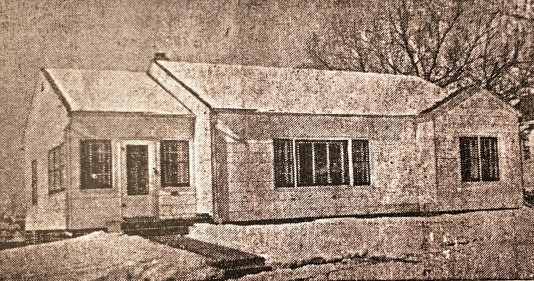 Leora Goff Wilson lived at 505 North 4th Street in Guthrie Center for nearly forty years. It was a small two-bedroom home with one bathroom. Her big dining room table, which originally belonged to her folks when they lived in the Victorian house during the 1920s, barely fit in the dining room, so it was hard to get everyone seated.
Leora Goff Wilson lived at 505 North 4th Street in Guthrie Center for nearly forty years. It was a small two-bedroom home with one bathroom. Her big dining room table, which originally belonged to her folks when they lived in the Victorian house during the 1920s, barely fit in the dining room, so it was hard to get everyone seated.
Leora, 58, and her mother, Laura Goff, moved into the new house February 10, 1948. Laura, age 79, had been living in Omaha near several sons since the Great Depression. The widows made a home together in that little house for four fourteen years, until Laura died in late 1962 (my freshman year of college). Leora, by then 72 years old, had never lived alone before.
The house had a full basement, with very steep open stairs. The furnace and the washing machine were down there, along with an extra bed and the buffet that matched the big dining room table. Every autumn, Leora lugged potted plants (including a really nice rubber plant) down those steep steps to store until spring. She’d find pots for plants still in the ground so they could also overwinter in the basement.
When the little house was sold in 1988, the new owners bought the even smaller house to the north and had it taken down. Using both lots, they remodeled Leora’s house, building the new part to the north. The front entrance is north of where the old one was. You’d never guess this handsome home started out as a tiny white frame house.

May 28, 2024
The “Leora books”–world and national events reach into the American Heartland
Through one Iowa family, the “Leora books” tell stories about world and national events reaching into the American Heartland–westward expansion, two world wars, pandemics, mental health issues, the Great Depression, and dealing with great personal losses. The stories of courageous Leora Goff Wilson are hopeful as well.
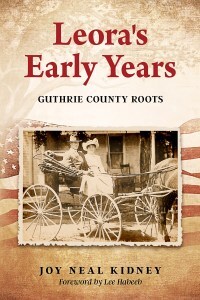 Leora’s Early Years
Leora’s Early Years
The oldest of ten children, Leora Goff gathered the tenacity, optimism and hope to endure dozens of family moves, great losses, an influenza pandemic, brothers drafted for the Great War.
When she married Clabe Wilson, they became forged into parents who would shepherd their own family of seven children through two more eras of world and local history–the Great Depression and WWII.
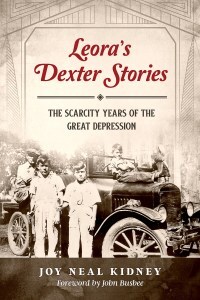 Leora’s Dexter Stories
Leora’s Dexter Stories
Leora Wilson hoped that one day she and husband Clabe could have a home of their own where their youngsters could thrive and all earn high school diplomas, which she had not been allowed as a girl.
But in the undertow of the Great Depression, those dreams were jeopardized by the struggle just to survive. The Wilsons were faced with a heartless landlord, nine children with whooping cough, a needle jammed in Leora’s hand, and relentless unemployment. Their two oldest sons joined the Navy in order to have jobs and enough to eat.
As the Wilsons slowly slid into poverty, Leora tried to keep her dreams alive while making a haven for her flock in one run-down house after another.
Leora’s Letters
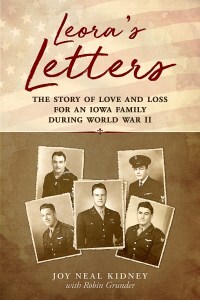 Five sons served. Only two came home. One son was already in the Navy before Pearl Harbor was attacked. The four others worked with their father as tenant farmers near Minburn, Iowa, until–one by one, all five sons were serving their country.
Five sons served. Only two came home. One son was already in the Navy before Pearl Harbor was attacked. The four others worked with their father as tenant farmers near Minburn, Iowa, until–one by one, all five sons were serving their country.
Along with her regular chores of cooking and cleaning, gardening and taking care of chickens, Leora wrote hundreds of letters, dispensing news and keeping up the morale of the whole family, which included two adult daughters.
Leora’s Letters is the compelling account of a woman whose most tender hopes were disrupted by great losses. Three of her sons lost their lives during the war, yet Leora lived out four more decades with hope and resilience.
What Leora Never Knew
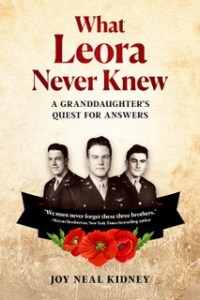 What Leora Never Knew: A Granddaughter’s Quest for Answers is my journey of research into what happened to the three Wilson brothers, tenant farmers who became pilots and who lost their lives during World War II.
What Leora Never Knew: A Granddaughter’s Quest for Answers is my journey of research into what happened to the three Wilson brothers, tenant farmers who became pilots and who lost their lives during World War II.
“We must never forget these three brothers.” – Marcus Brotherton, New York Times bestselling author
“This reviewer, a World War II aviation historian, was very impressed with the author’s determined and exhaustive research.” – Steve Blake, Co-editor of Lightning Strikes! publication of the P-38 National Association.
About the Author
 I’m the oldest granddaughter of Leora Wilson. As a child, I helped Grandma, along with my mother and her sister, take Memorial Day bouquets to the graves of three young uncles, not knowing that only one of them is buried here in Iowa–until decades later, after losing my courageous little grandma and reading the family’s WWII letters for the first time.In order to tell Grandma Leora’s stories, I published the first book at age 75. My husband, Guy (an Air Force Veteran of the Vietnam War and retired Air Traffic Controller) and I live in central Iowa. Our son and his wife live out-of-state with a small daughter named Kate. I’m aging gratefully, having lived with fibromyalgia for two dozen years, giving me plenty of home-bound days to write stories. —–Please visit my website. And my Amazon Author Page. Autographed copies are available in the Des Moines area. Amazon carries hardcovers, paperbacks, ebooks, and the first three are available as audiobooks.
I’m the oldest granddaughter of Leora Wilson. As a child, I helped Grandma, along with my mother and her sister, take Memorial Day bouquets to the graves of three young uncles, not knowing that only one of them is buried here in Iowa–until decades later, after losing my courageous little grandma and reading the family’s WWII letters for the first time.In order to tell Grandma Leora’s stories, I published the first book at age 75. My husband, Guy (an Air Force Veteran of the Vietnam War and retired Air Traffic Controller) and I live in central Iowa. Our son and his wife live out-of-state with a small daughter named Kate. I’m aging gratefully, having lived with fibromyalgia for two dozen years, giving me plenty of home-bound days to write stories. —–Please visit my website. And my Amazon Author Page. Autographed copies are available in the Des Moines area. Amazon carries hardcovers, paperbacks, ebooks, and the first three are available as audiobooks.
May 21, 2024
Comet Halley and an Eclipse of the Moon, May 1910
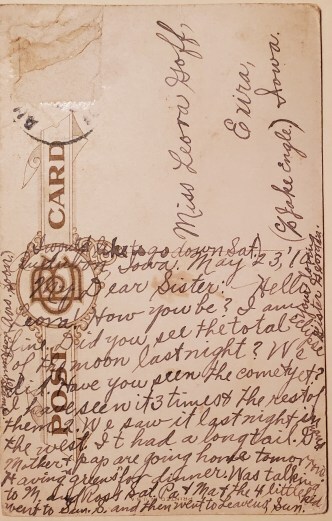 Postcard to Miss Leora Goff, Exira, Iowa (c/o Jake Engle), May, 1910.
Postcard to Miss Leora Goff, Exira, Iowa (c/o Jake Engle), May, 1910.
Dear Sister: - Hello Leora! How you be? I am fine. Did you see the total eclipse of the moon last night? We did. Have you seen the comet yet? I have seen it 3 times and the rest of them 2. We saw it last night in the west. It had a long tail. Grand Mother & pap are going home tomorrow. Having "greens" for dinner. Was talking to M. & Ross Sat. Pa & Ma & the 4 little kids went to Sun. S. and then went to Leavens' Sun.
(On the right: Your loving Sister Georgia.
(On the left: Ans. soon Look under stamp
Now we know why the green one-cent stamp is missing.
Leora was attending Mrs. Connrardy’s sewing school. In her memoirs, she mentioned seeing Comet Halley, but it was fun to find her sister Georgia’s confirmation on an old postcard.
There are more Audubon County stories in Leora’s Early Years: Guthrie County Roots. Audubon is the neighboring county to the west of Guthrie County. The Goffs lived there only six years, but some of my favorite stories are from those days.

May 18, 2024
What on Earth are Kindle Edition Normalized Pages?
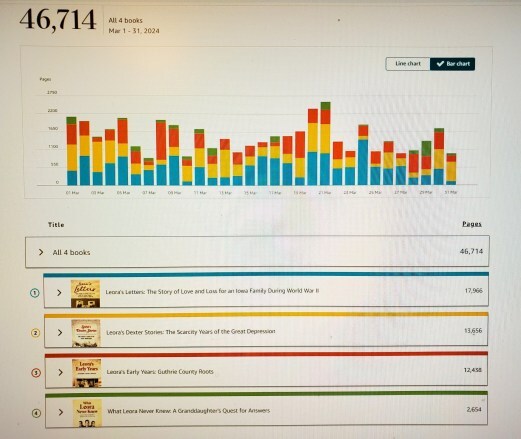 An ebook doesn’t have pages per se, so Amazon creates a “normalized” page-length, depending on how long it is. People who sign up for KU (Kindle Unlimited) can “borrow” Select books and read them, without paying anything beyond their $10 a month fee. If they “borrow” your book rather than buying it outright, you don’t get royalties, but you do get paid based on how many “normalized pages” were read (less than half a cent per page).
An ebook doesn’t have pages per se, so Amazon creates a “normalized” page-length, depending on how long it is. People who sign up for KU (Kindle Unlimited) can “borrow” Select books and read them, without paying anything beyond their $10 a month fee. If they “borrow” your book rather than buying it outright, you don’t get royalties, but you do get paid based on how many “normalized pages” were read (less than half a cent per page).
The graph shows, day by day, how many KENP were read of each book.
It’s interesting that more pages of Leora’s Early Years have been read this month. Last month, it was Leora’s Dexter Stories. During March (above), it was Leora’s Letters.
I’m so thankful that readers are getting acquainted with the life of the courageous little Leora Goff Wilson!
May 16, 2024
Heartbreaking true story of young WWll pilots and the courage of their family through it all
This is the compelling review of What Leora Never Knew: A Granddaughter’s Quest for Answers by author and photojournalist David LaBelle:
 “When I finished reading What Leora Never Knew, I didn’t know whether to clap or cry. Internally, I did both. Knowing the details of what happened to each young pilot was sobering and sad. Yet, as truth often brings, there is a comforting peace in knowing the details about those we love and have lost.
“When I finished reading What Leora Never Knew, I didn’t know whether to clap or cry. Internally, I did both. Knowing the details of what happened to each young pilot was sobering and sad. Yet, as truth often brings, there is a comforting peace in knowing the details about those we love and have lost.
“Like the Joads in Steinbeck’s Grapes of Wrath, we are introduced to the dreams, hardships and heartbreaks of Clabe and Leora Wilson and their children. After just a few pages, they feel like family, and the letters Joy Kidney recovered and shared, were written to us. And unlike fictional tales, these are true stories of love and courage of average Americans in the shadow of war and depression. A tireless researcher, Kidney has an unusual gift for sorting through thousands of letters, interviews and government documents and then weaving a story so personal it is as if we are sitting by a wood stove in winter listening to her tell it.
“I recommend you start at the beginning with Leora’s Letters and read each book in the order they were written.”
Photojournalist David LaBelle is the author of the poignant Bridges and Angels: The Story of Ruth, as well as several books on photography. Please have a look at his website.
He will teach a workshop next month at the Cedar Falls Christian Writer’s Conference.
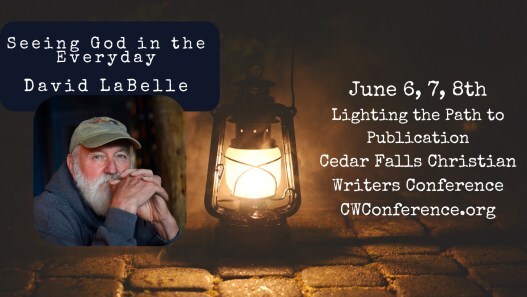
May 14, 2024
Rocky Fork Predestinarian Baptist Church
 Jackson is the most SE township of Parke County, Indiana. Parke County is near the west side of Indiana, just west of Indianapolis.
Jackson is the most SE township of Parke County, Indiana. Parke County is near the west side of Indiana, just west of Indianapolis.I dug a little deeper into the findagrave details about Rocky Fork Church. It was organized about 1832 by Lemuel Branson and a few others. This Baptist church was a hewed log structure about 20 by 28 feet, with a clapboard roof, a batten door midway in one side of the building, with a high pulpit opposite the door. A wood burning stove in the center warmed the room.
Located in Section 9 in the southeast part of Jackson Township, Parke County, Indiana, the building also served as a school. It’s listed as a Predestinarian Baptist church in the book listed below. (In his obituary of another ancestor, David Jordan, he was “babtised [sic] into the fellowship of the church of Jesus Called Sharon of Regular Predestinarian Baptists.” I’d never heard that term before.
Lemuel and Jane (Watson) Branson and Levi and Elizabeth Moore were some of the members. Lemuel Branson died in 1838. Five years later, his widow Jane married Levi Moore, who had also been widowed. Jane Watson Branson Moore was widowed a second time after she and Levi were married only four years.
Jane stayed behind with other family members in Indiana while son John Branson’s family took off for the new State of Iowa, followed by John’s sister and family, Emilia and Ephraim Moore in 1855. During the 1850s, the population of Iowa nearly tripled. Ohio and Indiana contributed more settlers than all other states.
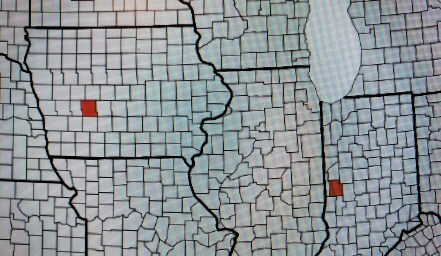
Google estimates the trip from Parke County, Indiana, to Guthrie County, Iowa, of about 500 miles, would take a little less than 8 hours. It took Ephraim and Lucy Moore and their family, in two covered wagons, about a month in 1855.
Rocky Fork church was disbanded in 1863. It, like other churches, “did not survived the controversies incident to the Civil War,” according to a history of Indiana churches.
Nevertheless, the legacy of that little church was nurtured through my motherline and woven into my own inheritance, that of lives lived with faith in the God, family, community, and the hope of heaven.
For the Lord is good and his love endures forever; his faithfulness continues through all generations. – Psalm 100:5
Archaeological and History Survey of Parke County by George Branson, Indiana History Bulletin, August 1927, page 109f.
Rocky Fork Church
 Jackson is the most SE township of Parke County, Indiana. Parke County is near the west side of Indiana, just west of Indianapolis.
Jackson is the most SE township of Parke County, Indiana. Parke County is near the west side of Indiana, just west of Indianapolis.I dug a little deeper into the findagrave details about Rocky Fork Church. It was organized about 1832 by Lemuel Branson and a few others. This Baptist church was a hewed log structure about 20 by 28 feet, with a clapboard roof, a batten door midway in one side of the building, with a high pulpit opposite the door. A wood burning stove in the center warmed the room.
Located in Section 9 in the southeast part of Jackson Township, Parke County, Indiana, the building also served as a school. It’s listed as a Predestinarian Baptist church in the book listed below. (In his obituary of another ancestor, David Jordan, he was “babtised [sic] into the fellowship of the church of Jesus Called Sharon of Regular Predestinarian Baptists.” I’d never heard that term before.
Lemuel and Jane (Watson) Branson and Levi and Elizabeth Moore were some of the members. Lemuel Branson died in 1838. Five years later, his widow Jane married Levi Moore, who had also been widowed. Jane Watson Branson Moore was widowed a second time after she and Levi were married only four years.
Jane stayed behind with other family members in Indiana while son John Branson’s family took off for the new State of Iowa, followed by John’s sister and family, Emilia and Ephraim Moore in 1855. During the 1850s, the population of Iowa nearly tripled. Ohio and Indiana contributed more settlers than all other states.

Google estimates the trip from Parke County, Indiana, to Guthrie County, Iowa would take a little less than 8 hours. It took Ephraim and Lucy Moore and their family, in two covered wagons, about a month in 1855.
Rocky Fork church was disbanded in 1863. It, like other churches, “did not survived the controversies incident to the Civil War,” according to a history of Indiana churches.
Nevertheless, the blessings of the Bible taught in Indiana’s Rocky Fork church followed my motherline to Iowa. Those blessings were nurtured through several lifetimes and woven into my own inheritance, that of lives lived with faith in the God, family, community, and the hope of heaven.
For the Lord is good and his love endures forever; his faithfulness continues through all generations. – Psalm 100:5
Archaeological and History Survey of Parke County by George Branson, Indiana History Bulletin, August 1927, page 109f.
May 11, 2024
A Mother’s Day Tornado and More

Guthrie County, Iowa
May 10, 1959
The Mother’s Day tornado of 1959 is the first one I remember watching. We were at Grandma Leora’s. Her mother, Laura Goff who lived with her, had been in the Guthrie Center hospital since the day before. Two of Leora’s brothers, Merl and Willis Goff, came from Omaha with their families. Also, “Warrens & Darlene came to hospital in P.M. to see Mother.”
“hail at 1:30 P.M. Tornados between 2 and 3 P.M. – went out to where one tornado was. bad. Willis got movies of it.”
 Diary of Leora Goff Wilson, May 1959
Diary of Leora Goff Wilson, May 1959My sister Gloria and I remember the tornado skirting Guthrie Center on the north. Before heading home, we drove north out of town to check damage. A barn had been hit, hay strewn all over, and hogs acted dazed.
Driving home from Grandma’s
The only other tornado I’ve watched was also during the 1950s, also in Guthrie County. We were headed home from Grandma’s, having turned east onto White Pole Road from Highway 25. A tornado north of us traveled east parallel to our car, but we didn’t witness any damage.
Dallas County, Iowa
This tornado story is even better!
The day cousin Judith Neal was born, May 21, 1945, a tornado knocked out electricity to the town of Dexter, Iowa. The hospital had its own generator so didn’t lose power.
Judy’s dad, Willis “Bill” Neal, was serving overseas as the pilot of a C-47 flying missions over “the Hump.” Her mother Helen had been staying with her folks. When Bill got back to the States three months later, he called from New York, not knowing whether he was the father of a son or daughter. At first Helen thought he was kidding, but none of the Red Cross telegrams had reached him.
Judy said “Grandpa Cook always teased me about coming in on the tail of a tornado on May 21st, 1945.”
May 9, 2024
Mother’s Day 1944, “Bruce” was due in a couple of weeks
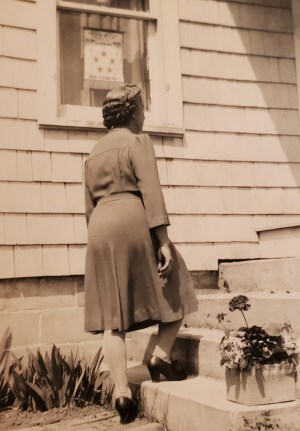 The Wilson family’s service flag in the window shows that five sons are serving in the war. Dale Wilson had been MIA since the November before.
The Wilson family’s service flag in the window shows that five sons are serving in the war. Dale Wilson had been MIA since the November before.One day in May 1944, Doris (staying in Iowa to have her first baby) wrote Warren (teaching advanced cadets in Texas) that she’d just had a perfect day. She and her mother (Leora) did the laundry so she and “Bruce” (the baby-to-be) got lots of sunshine while hanging clothes out on the line. That afternoon, they’d walked up the hill to watch her father (Clabe) plow, then came back through the timber and picked wildflowers.
May is the essence of spring in Iowa, with blues and purples of wild violets, the frothy white of plum thickets, songs of migrating birds of all kinds, and an earthy, woodsy aroma.
For Mother’s Day, Doris bought flowers for the front steps for her mother, fixed her hair, and they must have gone to town since Leora is all dressed up.
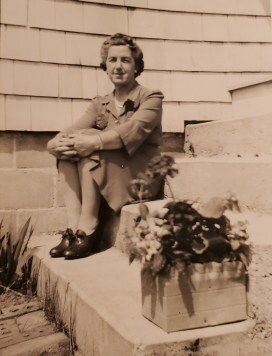 Leora Wilson, Mother’s Day. May 14, 1944, Minburn, Iowa
Leora Wilson, Mother’s Day. May 14, 1944, Minburn, IowaAnother day the ladies helped Clabe get a couple of sows penned in. Those sows didn’t want to give up their little weed patches for a hog house with clean straw, Doris wrote her husband, but with “a little maneuvering and persuasion,” they finally did.
“Isn’t that interesting?” she wrote. “Fourteen sows have little pigs, two cows have calves (so far), and two cats have kittens. Guess maybe I’ll be next.”
“Bruce” was due in a couple of weeks.
From Leora’s Letters: The Story of Love and Loss for an Iowa Family During World War II
May 7, 2024
Jane Branson of my Motherline
Jane (Watson) Branson (1782-1859) is the farthest back I know about my motherline. Jane’s father was David Watson, but I don’t know her mother’s name.
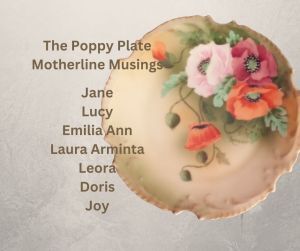
Jane Branson’s Legacy
Jane (Watson) Branson(1782-1859)
Born in Virginia in 1782, before there were States,
before the nation had a president, Jane Watson
married Lemuel Branson in Grainger County, Tennessee,
among the foothills of the Great Smoky Mountains.
Their six children, three sons and three daughters,
were loaded them up with their belongings to trundle
four hundred miles to Parke County, Indiana,
coaxed there by Lemuel’s only sister.
There Lemuel built a log church and meeting house,
which he called Rocky Fork. Twenty by twenty-eight feet,
a wood stove at its center, a tall pulpit at one end.
Among the worshipers were Levi and Elizabeth Moore.
Jane was in her mid-fifties when Lemuel died.
Not long after, Levi lost his wife. Jane married Levi,
but was widowed again only four years later.
She ceded her portion of Levi’s estate to his sons.
Son John Branson and his family were lured west.
Jane watched their wagons disappear in the distance,
then those of daughter Lucy Branson Moore’s family,
to join her brother in the young State of Iowa.
Jane Branson’s granddaughter Emilia was just 8 years old
when her folks left Indiana with seven children in two wagons
on May 6, 1855, along with recollections of Rocky Fork,
and of a grandmother’s legacy of faith and integrity.



